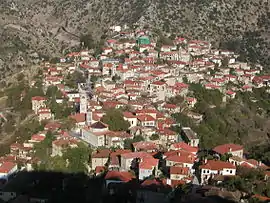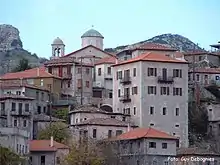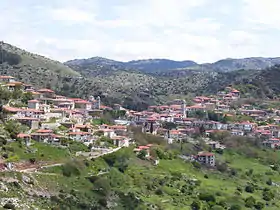Dimitsana
Dimitsana (Greek: Δημητσάνα) is a mountain village and a former municipality in Arcadia, Peloponnese, Greece. Since the 2011 local government reform it is part of the municipality Gortynia, of which it is the seat and a municipal unit.[2] The municipal unit has an area of 110.759 km2.[3] Dimitsana is built on the ruins of the ancient town Teuthis. The population of the village is 342 (2011 census), while it was 611 in 2001. It has been registered as a traditional settlement.
Dimitsana
Δημητσάνα | |
|---|---|
 | |
 Dimitsana Location within the regional unit  | |
| Coordinates: 37°36′N 22°3′E | |
| Country | Greece |
| Administrative region | Peloponnese |
| Regional unit | Arcadia |
| Municipality | Gortynia |
| • Municipal unit | 110.8 km2 (42.8 sq mi) |
| Elevation | 945 m (3,100 ft) |
| Population (2011)[1] | |
| • Municipal unit | 763 |
| • Municipal unit density | 6.9/km2 (18/sq mi) |
| Time zone | UTC+2 (EET) |
| • Summer (DST) | UTC+3 (EEST) |
| Postal code | 220 07 |
| Area code(s) | 27950 |
| Vehicle registration | TP |
| Website | www |
Dimitsana is built on a mountain slope at an elevation of 950 meters. From its southern side a marvelous view of Megalopolis plain and Taygetus is provided. Dimitsana is located 53 km east of Pyrgos, 31 km northwest of Tripoli, 23 km northwest of Megalopoli and 17 km northeast of Andritsaina. The village has a school, a historical library, several churches, a post office, an open-air water-power museum,[4] an open amphitheater, hotels and a square.
History


At the site of present-day Dimitsana there was, in ancient times, the ancient Arcadian town Teuthis that had participated in the Trojan War, but also in the colonization of Megalopolis.
In 963 Philosophou Monastery was founded 2,5 km from Dimitsana. The name of the town is first recorded in 967 in a Patriarchate's document related to Philosophou Monastery. The first gunpowder mills of the town were built under the guise of home industry in the middle of the 18th century by Bishop Ananias Lakedaimonias, who paved a revolt against the Turks. In 1764 the movement was revealed and Ananias and his partners were killed. In the same year Agapios, a wise monk, built a library, where he moved the books of the monastery. The library was growing up constantly until 1821, as the Patriarchate offered new books and there was a seminary, known as Φροντιστήριο Ελληνικών Γραμμάτων (Tuition Centre of Greek Literature). A lot of bishops and scholars graduated from it, among them Patriarch Gregory V of Constantinople and Germanos III of Old Patras, whose houses have survived in the town.
After the Orlov events, some inhabitants of Dimitsana bearing the name "Tasoulis" (Greek: Τασούλης) migrated to Minor Asia fleeing the Albanian ravaging of Peloponnese.[5] Upon arrival in Koldere, in 1777, near Magnesia (ad Sipylum), they changed their name "Tasopoulos" (Greek: Τασόπουλος).[6]
Ιn the Greek War of Independence the Dimitsana gunpowder mills played an important role, but during the war a large part of its library's books were destroyed when Greek warriors used their paper in the 14 gunpowder mills that worked day and night, supplying them with gunpowder. For this reason Dimitsana has been called "the Nation's powder keg".
In 1960 Dimitsana's population was about 2,000, but a lot of people have since then emigrated to the United States, Australia and elsewhere.
Sights
Dimitsana is a stone-built village with remarkable mansions, most of which are now restored. It is a typical sample of Gortynia's architecture and it is registered as a traditional one. The statue of Patriarch Gregory V dominates in the central square and also the family houses of both him and Germanos III of Old Patras can be seen.
Dimitsana's Library contains today about 35,000 books, manuscripts and documents. In Dimitsana's Museum, housed in the Library, there are collections of weaving, looms and handicrafts and an archaeological one. The Elementary School was built 1898–1910, by a donation of Andreas Syngros, and is a characteristic sample of that period. It operated as a girls' school until 1930 and later as county court.
Not far from the village is the Open-air Water Power Museum (1997), created by restoration of abandoned pre-industrial facilities, based on the Water Power. It includes a flourmill, a traditional cauldron, a tannery, a tanner's house and a gunpowder mill.


In the surroundings important sights include the Old and the New Philosophou Monastery and Prodromou Monastery, both located inside Loussios's gorge.
Subdivisions
The municipal unit Dimitsana is subdivided into the following communities (constituent villages in brackets):
- Dimitsana (Dimitsana, Karkalou, Moni Aimyalon i Filosofou, Palaiochori)
- Melissopetra
- Panagia
- Rados
- Rizospilia (Rizospilia, Kato Rizospilia)
- Zatouna (Zatouna, Vlongos, Markos)
- Zigovisti
Notable people
- Germanos, metropolitan bishop of Patras (1771–1826)
- Gregory V (1746–1821), Ecumenical Patriarch of Constantinople
- Theophanes III (1570-1644), Greek Orthodox Patriarch of Jerusalem
- Tassos Gritsopoulos, historian
- Archbishop Ieremias of Gortyna
Gallery
 House in Dimitsana
House in Dimitsana Old house restored
Old house restored The statue of Gregory V in Dimitsana
The statue of Gregory V in Dimitsana Orthodox church
Orthodox church Panoramic view
Panoramic view
References
- "Απογραφή Πληθυσμού - Κατοικιών 2011. ΜΟΝΙΜΟΣ Πληθυσμός" (in Greek). Hellenic Statistical Authority.
- "ΦΕΚ B 1292/2010, Kallikratis reform municipalities" (in Greek). Government Gazette.
- "Population & housing census 2001 (incl. area and average elevation)" (PDF) (in Greek). National Statistical Service of Greece. Archived from the original (PDF) on 2015-09-21.
- Piraeus Bank Group Cultural Foundation description of the museum
- Σάθας Κωνσταντίνος, Τουρκοκρατουμένη Ελλάς. Ιστορικόν δοκίμιον περί των προς αποτίναξιν του οθωμανικού ζυγού επαναστάσεων του Ελληνικού έθνους (1453-1821). Αθήνα, 1869, σελ. 524.(in Greek)
- H καταγωγή των Κολτεριωτών της Σμύρνης – Του Μωυσιάδη Παναγιώτη e-ptolemeos.gr (in Greek)
External links
- Municipality of Dimitsana (official site, pages in Greek and in English)
- Dimitsana
- Dimitsana in Gortynia (in Greek)
- GTP - Dimitsana
- GTP - Dimitsana municipality
- Piraeus Bank Group Cultural Foundation open air water-power museum